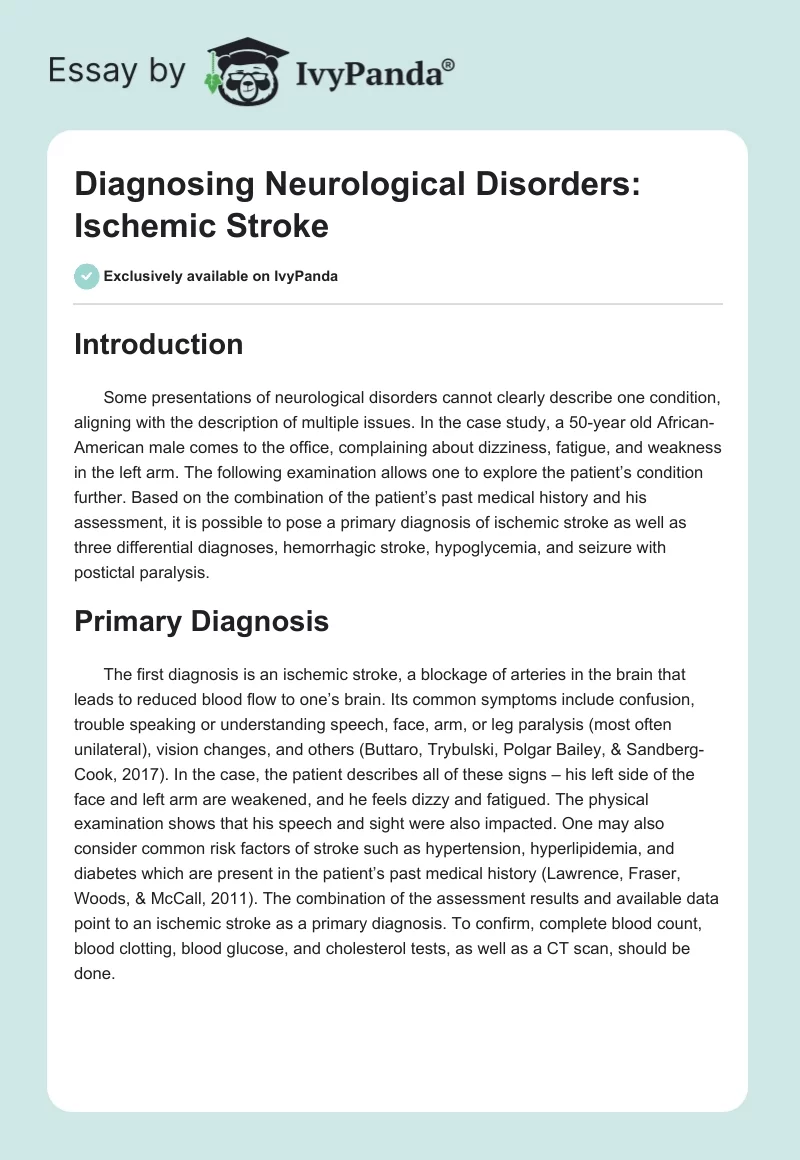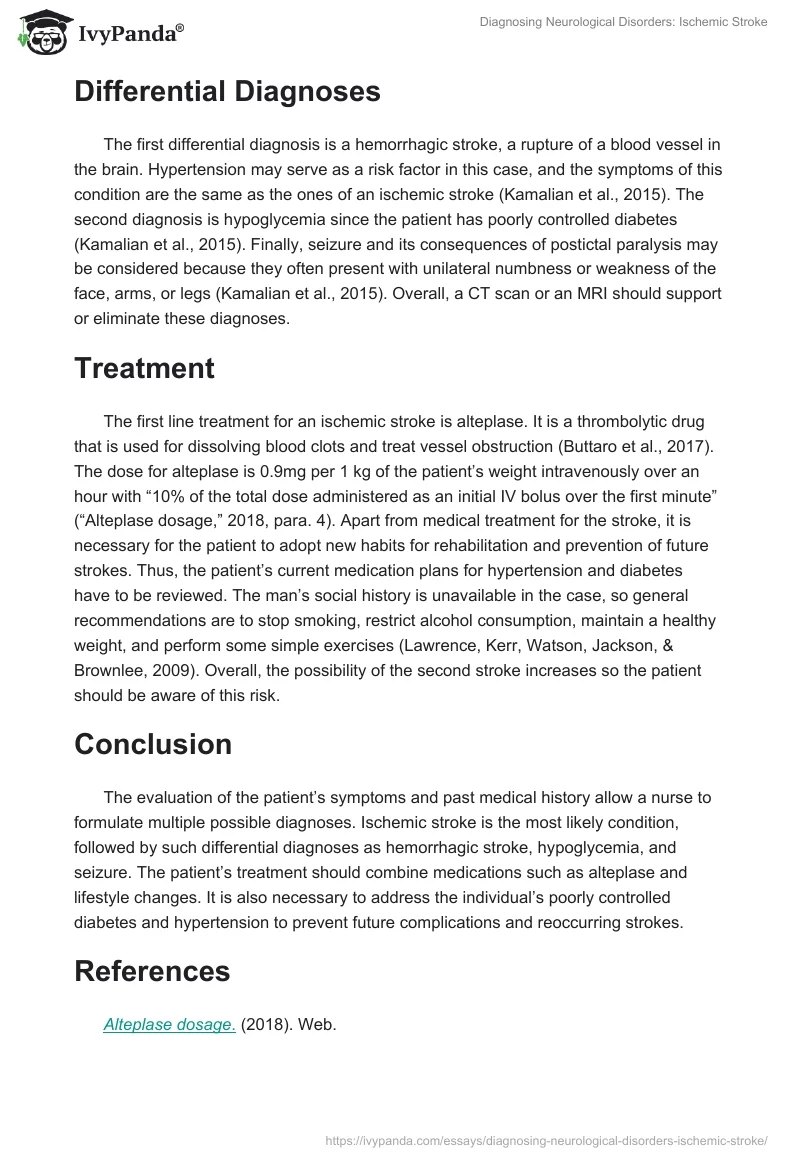Introduction
Some presentations of neurological disorders cannot clearly describe one condition, aligning with the description of multiple issues. In the case study, a 50-year old African-American male comes to the office, complaining about dizziness, fatigue, and weakness in the left arm. The following examination allows one to explore the patient’s condition further. Based on the combination of the patient’s past medical history and his assessment, it is possible to pose a primary diagnosis of ischemic stroke as well as three differential diagnoses, hemorrhagic stroke, hypoglycemia, and seizure with postictal paralysis.
Primary Diagnosis
The first diagnosis is an ischemic stroke, a blockage of arteries in the brain that leads to reduced blood flow to one’s brain. Its common symptoms include confusion, trouble speaking or understanding speech, face, arm, or leg paralysis (most often unilateral), vision changes, and others (Buttaro, Trybulski, Polgar Bailey, & Sandberg-Cook, 2017). In the case, the patient describes all of these signs – his left side of the face and left arm are weakened, and he feels dizzy and fatigued. The physical examination shows that his speech and sight were also impacted. One may also consider common risk factors of stroke such as hypertension, hyperlipidemia, and diabetes which are present in the patient’s past medical history (Lawrence, Fraser, Woods, & McCall, 2011). The combination of the assessment results and available data point to an ischemic stroke as a primary diagnosis. To confirm, complete blood count, blood clotting, blood glucose, and cholesterol tests, as well as a CT scan, should be done.
Differential Diagnoses
The first differential diagnosis is a hemorrhagic stroke, a rupture of a blood vessel in the brain. Hypertension may serve as a risk factor in this case, and the symptoms of this condition are the same as the ones of an ischemic stroke (Kamalian et al., 2015). The second diagnosis is hypoglycemia since the patient has poorly controlled diabetes (Kamalian et al., 2015). Finally, seizure and its consequences of postictal paralysis may be considered because they often present with unilateral numbness or weakness of the face, arms, or legs (Kamalian et al., 2015). Overall, a CT scan or an MRI should support or eliminate these diagnoses.
Treatment
The first line treatment for an ischemic stroke is alteplase. It is a thrombolytic drug that is used for dissolving blood clots and treat vessel obstruction (Buttaro et al., 2017). The dose for alteplase is 0.9mg per 1 kg of the patient’s weight intravenously over an hour with “10% of the total dose administered as an initial IV bolus over the first minute” (“Alteplase dosage,” 2018, para. 4). Apart from medical treatment for the stroke, it is necessary for the patient to adopt new habits for rehabilitation and prevention of future strokes. Thus, the patient’s current medication plans for hypertension and diabetes have to be reviewed. The man’s social history is unavailable in the case, so general recommendations are to stop smoking, restrict alcohol consumption, maintain a healthy weight, and perform some simple exercises (Lawrence, Kerr, Watson, Jackson, & Brownlee, 2009). Overall, the possibility of the second stroke increases so the patient should be aware of this risk.
Conclusion
The evaluation of the patient’s symptoms and past medical history allow a nurse to formulate multiple possible diagnoses. Ischemic stroke is the most likely condition, followed by such differential diagnoses as hemorrhagic stroke, hypoglycemia, and seizure. The patient’s treatment should combine medications such as alteplase and lifestyle changes. It is also necessary to address the individual’s poorly controlled diabetes and hypertension to prevent future complications and reoccurring strokes.
References
Alteplase dosage. (2018). Web.
Buttaro, T. M., Trybulski, J., Polgar Bailey, P., & Sandberg-Cook, J. (2017). Primary care: A collaborative practice (5th ed.). St. Louis, MO: Elsevier.
Kamalian, S., Kamalian, S., Boulter, D. J., Lev, M. H., Gonzalez, R. G., & Schaefer, P. W. (2015). Stroke differential diagnosis and mimics: Part 1. Applied Radiology, 44(11), 26-39.
Lawrence, M., Fraser, H., Woods, C., & McCall, J. (2011). Secondary prevention of stroke and transient ischemic attack. Nursing Standard, 26(9), 41–46.
Lawrence, M., Kerr, S., Watson, H. E., Jackson, J., & Brownlee, M. G. (2009). A summary of the guidance relating to four lifestyle risk factors for recurrent stroke. British Journal of Neuroscience Nursing, 5(10), 471–476.


